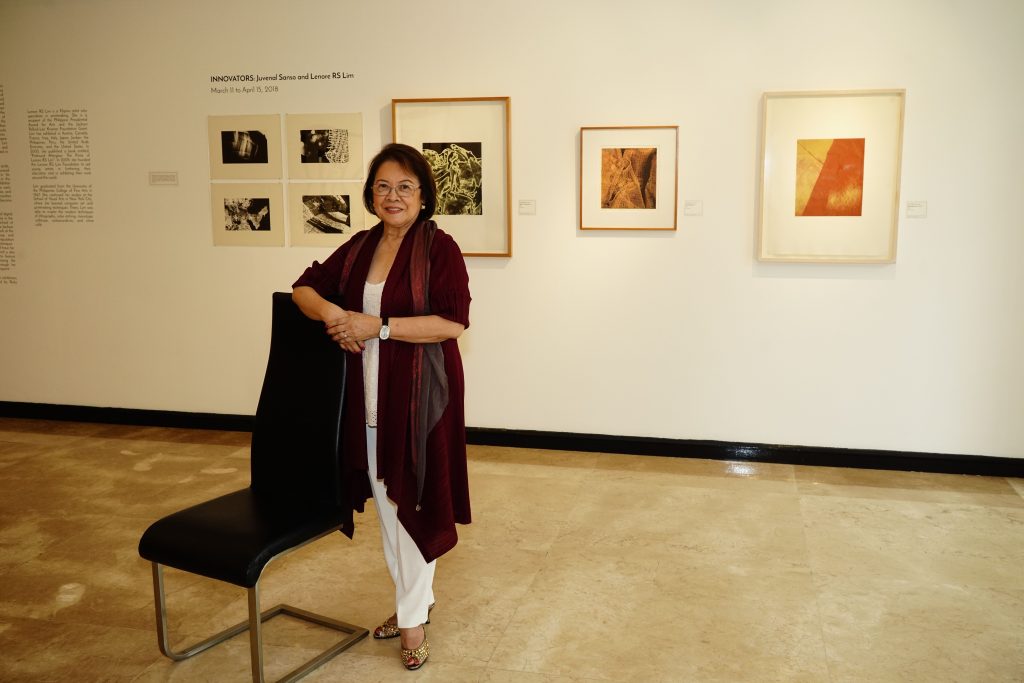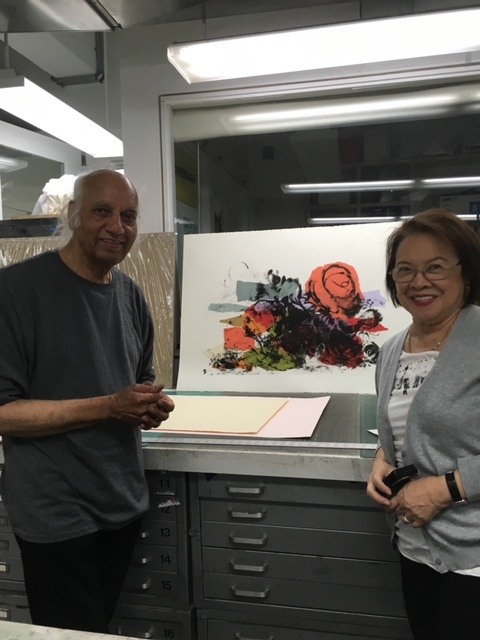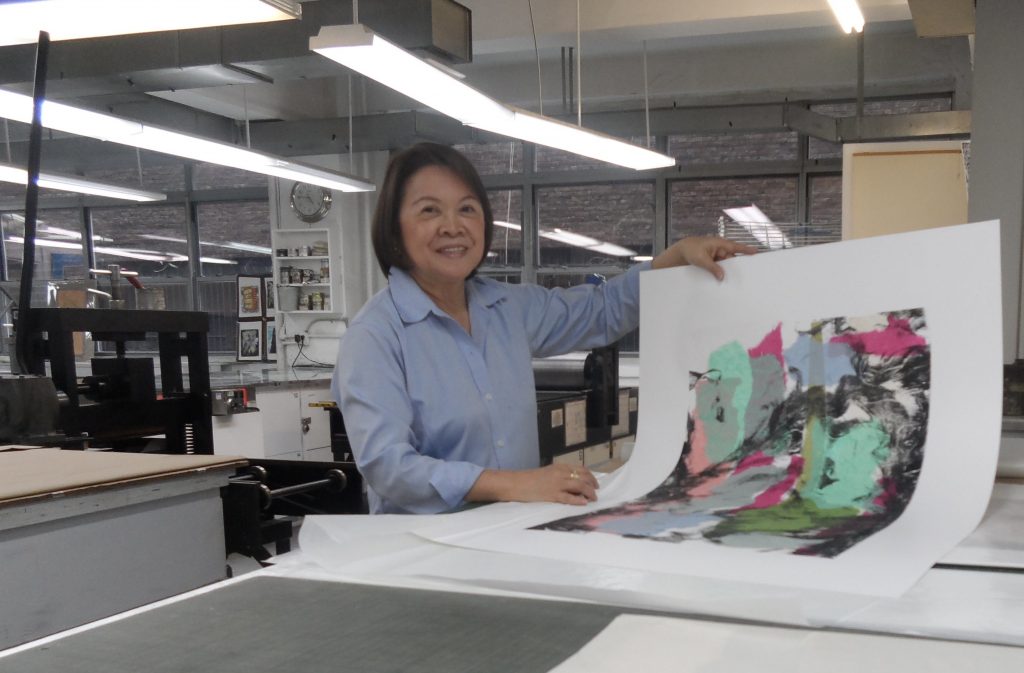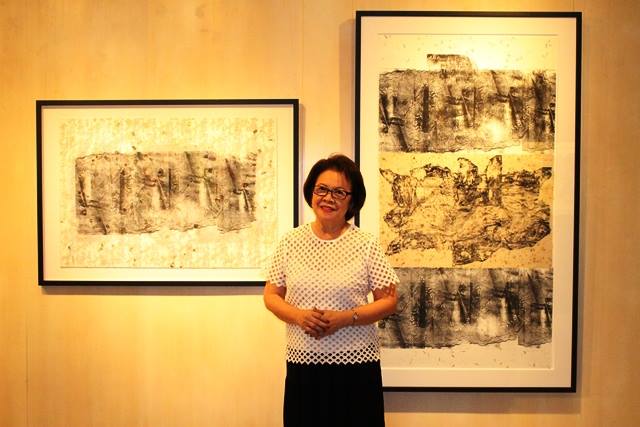Filipino-Canadian In Focus
Printmaker Lenore RS Lim’s story in print

Lenore RS Lim simply wanted to bring more life and beauty to her home with her art.
However, the impressive amount of artistry she has could not be handled by a single roof that it broke open to the visual arts scene locally and internationally.
Lenore is a skilled printmaker and mentor from the Philippines who chose to walk into the artistic career road, far from the one that most of her loved ones are taking.
She came from a family that is in the legal profession, composed of her mom who worked in the legislative department of the Senate of the Philippines, her dad who was a prosecutor at the Department of Justice (DOJ), and her youngest sibling who is a lawyer. Most of her relatives are also in that line of work.
Only she and her two older siblings took different career paths. Her older brother was in the financial institution, while her older sister was in the restaurant business.
Considering her family’s profession, it is a wonder how art breaks into their home.
Getting into art
Lenore studied at the College of the Holy Spirit in Mendiola which, during her time, was called Holy Ghost College run by nuns.
She grew up getting used to the go-to-school-then-come-back-home routine as she was not allowed by her strict parents to go out that much. Lenore would mostly spend her free time with her family or accomplishing other tasks like assignments for school if there are any.
She made it a habit to make her homeworks well-presented, therefore, she would take all the time she needed to do it. Her assignments were always written neatly and aesthetically pleasing because of the little illustrations she would put on it; such effort in the plain assignments did not escape her teacher’s notice.
One of the nuns, Sister Araceli, appreciated Lenore’s work and thought of signing her up in her free art lessons. The short classes were attended by selected students and were held every Saturday.
Lenore’s parents did not object to the idea of having an artist in their family, instead, they became her strong support system as she pursued a career in art. After finishing high school at the College of the Holy Spirit, Lenore, powered by her family’s support and Sister Araceli’s mentoring, furthered her studies in art at the University of the Philippines (UP) College of Fine Arts.
The art lessons became a factor for her to study Fine Arts, but what really motivated her to take that degree was her simple desire to become a housewife.
Lenore recalled how their parents were always working. When she was little, she would sometimes feel her parents’ busyness whenever she saw her classmates being picked up at school by their parents on time, while she was always picked up late by her parents.
The idea of becoming a housewife came to her because of her aunt who is also a housewife. Whenever she spent time with her aunt, Lenore would see her doing things for their household like baking for her family. She dreamed of doing things like that when it is her turn to be a mother.
“I grew up, my mother was always going to the office. So I said, I really wanted to be a housewife. If I take up Fine Arts, I could decorate the house.”
That was how she envisioned her future, however, this was far from what happened next after college graduation.
Change in plans
Lenore did not immediately get married after achieving her bachelor’s degree. What she did was take a teaching job for private art lessons.
A chance to teach at a school came along when a neighbor of hers, who was working at the Assumption Convent in Manila, asked her if she could take the place of their art teacher who had an urgent matter to deal with back at their province. Lenore did not let this slip and grabbed the offer to become a substitute art teacher for Grade 6 students for two weeks.
“It’s an art class for many students at their own desks but I have a way of conducting lessons and it went very well. The principal passed by [and] she saw everybody doing their work quietly.”
“Because she liked the way that I handled the class so much, what she did was she kept me even if the other teacher came back already and opened up an art class for another grade.”
Only a few months at the Assumption, another teaching job at the International School Manila knocked at her door which she welcomed right away.
Her full-time job was at the International School Manila, teaching from morning until noon, then she would go to Assumption for her two afternoon classes.
Lenore would also conduct art classes during summer. One day during that season, she met the man who was going to be her better half.
Jose Lim came into Lenore’s life as she was preparing herself to join an exchange program where she will be in Mobile, Alabama.
Jose’s father worked at the Department of Foreign Affairs and was assigned outside the Philippines, that being so, Jose grew up abroad and studied in Pakistan, South Korea, and Egypt. His family only came back to the Philippines when his father retired.
“It was really nice to talk to somebody who grew and studied outside the Philippines. There was so much to talk about and although he was not in the art field, he knew a lot about the art world because they go to museums. You get a different perspective.”
“Things I want to know more, he could tell. We had so much to talk about and that’s how we got to know each other.”
Through those talks, the two began to fall in love and eventually tie the knot. But even after the wedding, Lenore’s dream to become a housewife still did not happen.
First times
She did not drop the opportunity to go to Alabama.
The couple moved there in 1975, with Lenore continuing her plan to teach there, while her husband would study a few courses at the University of South Alabama. This is the first time Lenore has been to the United States.
School, where Lenore was in charge of did not have any art teachers, instead, homeroom teachers were the ones teaching children art. Lenore was not assigned to a particular school but at the headquarters of the Mobile County Public School System.
As an art resource teacher, it was her duty to visit schools to give art demonstrations to the homeroom teachers every week and then craft lesson plans on Fridays that she was at the headquarters.
This work lasted for eight months. After she left, Lenore said the lesson plans that she wrote were made into a handbook for the Mobile County Public School System.
“That was the first time I had something of my work being, you know, put together.”
Her short stay in Mobile, Alabama became more unforgettable because of how she was warmly welcomed.
“A lot of people were asking, ‘Why go to Alabama?’ But do you know what? I really enjoyed my stay there because people were so kind, warm, and friendly.”
Establishing home in Canada
Since that Mobile, Alabama trip, Lenore’s life has been a series of moving back and forth to other countries.
Instead of returning to the Philippines, which was placed under martial law at that time, Lenore and Jose decided to pin their next destination to Canada, touching down in Vancouver, British Columbia in the fall of 1975. There, they built their own family.
The first thing they took care of upon arriving in the city was to look for jobs. Jose applied at the Royal Bank of Canada where he became a manager, while Lenore was a part-time sales person at a dress shop. At that time, she got pregnant with their first child whom they named Claire.
Lenore and Jose welcomed Claire in 1976 and after four years, their son, Justin, came.
They may have grown up in Canada, but Lenore and Jose assured that their kids know a lot of things about their Filipino heritage by being actively involved in the Philippine community and with the consulate in Vancouver.
Other than joining various Filipino-Canadian organizations, the couple created their own organization in 1980 called Filipino Music and Art Foundation where they hold programs that highlight the culture of their motherland and invite Filipino artists to perform.
“We also presented Philippine night [because] we wanted to show the image of the Philippines. Not too many people here know about the Philippines at that time.”
“We were leaders of the community; we gave cultural events. We like to show off things about the Philippines, talk about the Philippines. [Our] daughter and son grew up knowing a lot about the Philippines.”
Lenore was supposed to get her Master’s in Art, however, the courses she took in the Philippines were not credited in Canada so she had to take up some classes that she had already taken before. Since she now has two wonderful children, Lenore rather took up early childhood education.
“Little did I know that early childhood would give me the work at the United Nations International School (UNIS).”
Pursuit of printmaking
She grabbed the opportunity to teach early childhood education at the UNIS and for that reason, her family moved to New York after living in Canada for more than a decade.
It was in 1988 that Lenore began her teaching job at the UNIS. Because of this, Claire and Justin, who were 12 years old and eight years old respectively during that time, were also able to study at the UNIS for free.
Their family planned to live in New York for only two years, but it changed when Lenore’s feet brought her to a place where she realized that her stay in the city would not end in the UNIS.
Lenore went to midtown Manhattan to visit the Museum of Modern Art, home to a hundred of thousands of fascinating works of modern and contemporary art.
There, she saw a show of printmakers. She was standing in front of it, absorbed by big creations of printmaking made by Robert Rauschenberg and Jasper Johns to name a few.
At that very moment, the words that sank to her mind were, “This is what I want to do.”
Next thing she knew, she enrolled in printmaking courses at the School of Visual Arts (SVA) in 1990. Lenore had tried printmaking before during her college days, doing serigraphy or screen printing only. At the SVA, her art underwent different processes of printmaking such as etching and lithography.

Aside from printmaking, she also took up computer art courses at night where she studied along with American masters of computer graphic arts. Lenore pursued a self-designed continuing program of learning new techniques of printmaking at the Robert Blackburn Printmaking Workshop, under the guidance of master printmaker Devraj Dakoji.
“Why did I choose that [printmaking]? First of all, it’s more democratic.”
Different from painting, this artistic process, according to Lenore, is more democratic in a sense that the artist could make multiple limited editions of it and equally divide the cost of the art to those who will have it.
“[For example], the artist who paints in oil on canvas. When they do it, they are able to produce one work. So let’s say, [they] want to sell it for $500. Who can buy the $500? Only the ones with more money. Whereas if I do it, let’s say, on a woodcut, or etching, or lithograph, I can make [a] limited edition because I have the design on the wood, on the metal or stone.”
“You can decide to make five, 10 or more. The more editions you have, the more you can divide the cost. The $500, if you make five, you can charge $100 per person. Five people will have it and you can do an artist copy.”
The artist would also do limited editions so that each individual work will retain its value over time.

Doing printmaking requires a lot of time to learn and finish. If it could take up so much of the artist’s day, what more to Lenore who manages varying roles? For the artist, teacher, full-time mother, and active member of her community, every stage is different.
“I can’t even imagine telling you how busy life was, really busy. I’m always trying to do things ahead.”
Lenore would always make sure that everything is in order in case she gets sick. She would prepare lectures so if ever she won’t be able to come back to the classroom the next day, the substitute teacher could still follow the lesson from where she left. At home, either she or her husband would prepare meals for the family and do some errands. Twice or thrice a week, Lenore would go to the studio for her artworks.
Her every day is indeed packed with different to-dos that balancing time became her main struggle as an artist. Buying art materials was also a problem for her since those were not included in their family budget.
But what really hindered her from walking through her artistic path was when she caught Hepatitis C virus. This showed up 10 years after she gave birth to her second child.
Lenore experienced complications after she delivered Justin through a caesarean section. After she was brought to the recovery room, Lenore continued to bleed so doctors had to do another operation on her. They had to transfuse blood on her, which she said, was “tainted.”
“At that time, it’s called non-A, non-B. they didn’t know the name yet until, finally, they named it hep C. They had to find a medicine so I was in the study.”
Because of this, she had to take off work for two years, a year for the treatment and another year to get over the side effects of the medication.
“It was really hard. I was in bed; it was [like] having the flu [for] almost the whole year.”
“If I didn’t have it treated it becomes cancer of the liver; it will become cirrhosis. But because mine was caught early on, I was able to follow whatever they (the doctors) said.”
Lenore did not go to the war alone; she had a strong army, a.k.a her friends and family — especially her husband, standing behind her to back her up. With them, she became more creative and found ways of getting around the challenges.
A friend of hers asked her to apply for the Pollock-Krasner Foundation grant which she was able to get. The fund she received from the grant was used to buy the art materials she needed and get an assistant who will help her with her artworks.
The battle eventually ended with Lenore being the victor. She went on her journey to conquer the international art scene.
Standing out in global art scene
Her printmaking and computer arts courses continued at the SVA until she finished in 1995.
A year later, she held her third solo exhibit at the Philippine Center in New York, the same venue where she had her first-ever exhibit in April 1991. In August 1991, she had her second exhibit at the Ayala Museum in the Philippines, making her the first printmaker to have a solo show of Computer Art Photo Etchings and Serigraphy in the venue.
From New York and the Philippines, her artworks stormed into museums, cultural centers, exhibitions, and festivals in South East Asia, Americas, Europe, and the Middle East. The seasoned printmaker also bagged multiple recognition and awards both locally and internationally, including the Outstanding Artist Award from the University of the Philippines and the Ma-Yi Theater in New York, The Presidential Pamana ng Pilipino Award, Outstanding Professional Awardee for Fine Arts, Women’s Achievers Award, and 100 Most Influential Filipina Women, among many others.
This success would not happen without her unending dedication to art and determined efforts exerted on her works all through the years. If one would ask how long it takes Lenore to reach this, the answer would be:
“I can just say it took me a day to print but to create and to get to this level, it took me a lifetime. Because everything that I do now is the result of the things I did before and learned before.”
“Others say, ‘when you buy an artwork, you’re not just buying a piece of paper with paint; you’re buying [a] part of the life of the artist because whatever the artist puts there, it’s part of the life they have experienced or wants to show.’ Not everybody feels that way about art. When you buy a piece of art, the soul is in it.”
In each of her artwork, Lenore would show things that are very important to her, whether it is related to the Philippines and family or something that always has a story.
It is not only the heart that the artists give in printmaking — they also put a lot of care into it.
Creating an edition, the printmakers would have to go through the whole process all over again for each copy, beginning from putting chemicals on the plate, applying ink, cleaning ink from the surface of the plate, carefully handling the paper to be placed on top of the plate to avoid from being stained, and then run it again on the press.
“You know that’s why you will not meet too many printmakers. It takes time, it’s messy, and [it requires] a lot of cleaning up.”
“Sometimes, they will say, ‘ay print lang ‘yan (it is just a print),’ but truly it’s just not a print. It’s a work of art and each one is original.”
More than sharing her art with a larger audience, Lenore wanted to encourage other people to try printmaking and support printmakers, and showcase the world-class Filipino talent.
Just as how she wanted to fill her home with artworks, she also hopes for the vibrant works of the Filipino artists to grace the houses of their fellow countrymen.
“I would like every Filipino home to have an original work of art of Filipino artists.”
Her legacy
Although she was already taking the printmaking industry by storm, Lenore still fulfilled her full-time teaching job at the UNIS.
During holidays and summer break, she and her family had time to visit Vancouver for Christmas, fly to the Philippines for summer vacation, and then go back to New York for work. She continued teaching at the UNIS until 2006 and then after five years, she worked as an adjunct professor at the UP College of Fine Arts in 2011.
Lenore kept teaching until she retired to focus more on making art and supporting Filipino talent to make their mark on the global art scene.
Aside from holding her own art exhibits, she helps other Filipino artists to get more exposure by organizing exhibits for them.
One of the latest exhibits she helped to organize before the COVID-19 pandemic was the How Green Is Your Muse Exhibit (HGIYM)? exhibit in 2019 at the Surrey Art Gallery.
The exhibit, presented by the Filipino Music and Art Foundation in partnership with the Philippine Consulate General in Vancouver, was participated by 12 Filipino-Canadian artists, including Lenore. In their artworks, the artists highlighted how they appreciate nature and how it inspires them.
She was not only helping artists to put up their exhibits; sometimes, Lenore couldn’t help but mentor a few people even after retiring. She was mentoring a high school student to do his portfolio for his application to an art school, but because of the pandemic, classes were conducted virtually.
“I call and I see the work to make sure… but of course, I provide the materials. That’s part of my foundation’s goal; to also help other people with limited… but not all because I also use my own money, I don’t do fundraising. I do a little help at the time just to make sure that somebody who I notice has a talent will be able to be accepted in a school.”
As she gives more focus on doing art, Lenore’s next plan is to come up with a book that will revolve around her art journey. This will be her second book, next to the one she released in 2005 titled, Profound Afterglow: The Prints of Lenore RS Lim.
“By this time, I think I’ve already received whatever I think I should but for now, what I really want to do is put together the second book, from 2005 to 2020. I can have another book about this second part of my journey.”

Lenore was also supposed to have a solo exhibit in Makati, Philippines last February 2021, the same month she celebrated her 75th birthday. However, the show did not push through due to the pandemic.
Time is flying so fast and everyone is not getting any younger. As much as she wished to, Lenore knew she would not be able to do so many things as she did in her younger years when she grows older. Reflecting on her career, Lenore hopes to leave an impactful and indelible mark that will go down in the history of visual arts and could fire enthusiasm to the younger generation of artists, just as how she was inspired to pursue printmaking.
“I don’t want to scare you but at this time of our lives [we] called [it] our last chapter. We can’t help it because from time to time, there’s a colleague or a friend who is passing away. When that happens, you think, ‘I should put this in order;’ things like that. So if I can finish the book that I plan to do, that would be great… and leave my legacy behind.”
As she works on her book, Lenore is also preparing to be part of a group exhibition in the Philippines in September. She also received invitations to have solo shows in Hong Kong and Taipei which are slated for 2022.
Lenore’s art journey is like a series of artworks that underwent the process of printmaking.
Her interest in art was ignited when her small drawings were noticed by Sister Araceli and made her join her art class. After she graduated from college, Lenore also taught not only a few young talents but a wide range of different students in the Philippines and abroad.
Like her aunt, she wanted to be a housewife who manages her family’s home and decorates it. She did become a wife and mother of two, although neither her duties nor her artworks revolve around their home. Perhaps her masterpieces are not meant to be displayed only on the walls of her house but bound to be shown to the world.
She was inspired by the artworks in that exhibit at the Museum of Modern Art, but now it is her who wanted to encourage others to do printmaking through the works of the printmakers, with her art pieces taking part in the motivating force this time.
There may be familiar phases, however, each stage in Lenore’s life is unique. Like the artworks done by printmaking, the same process may be repeated, but as what Lenore said, each of those is not just prints that came out from a huge press — they are original works of art that are beyond comparison.






















Cora Kalaw
June 20, 2021 at 10:57 AM
Lenore RS Lim is an inspiration to all of us…an example of a complete woman.